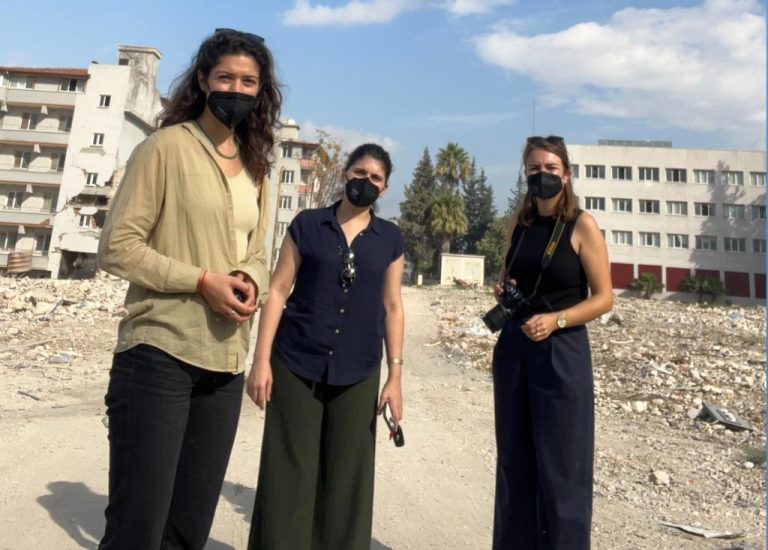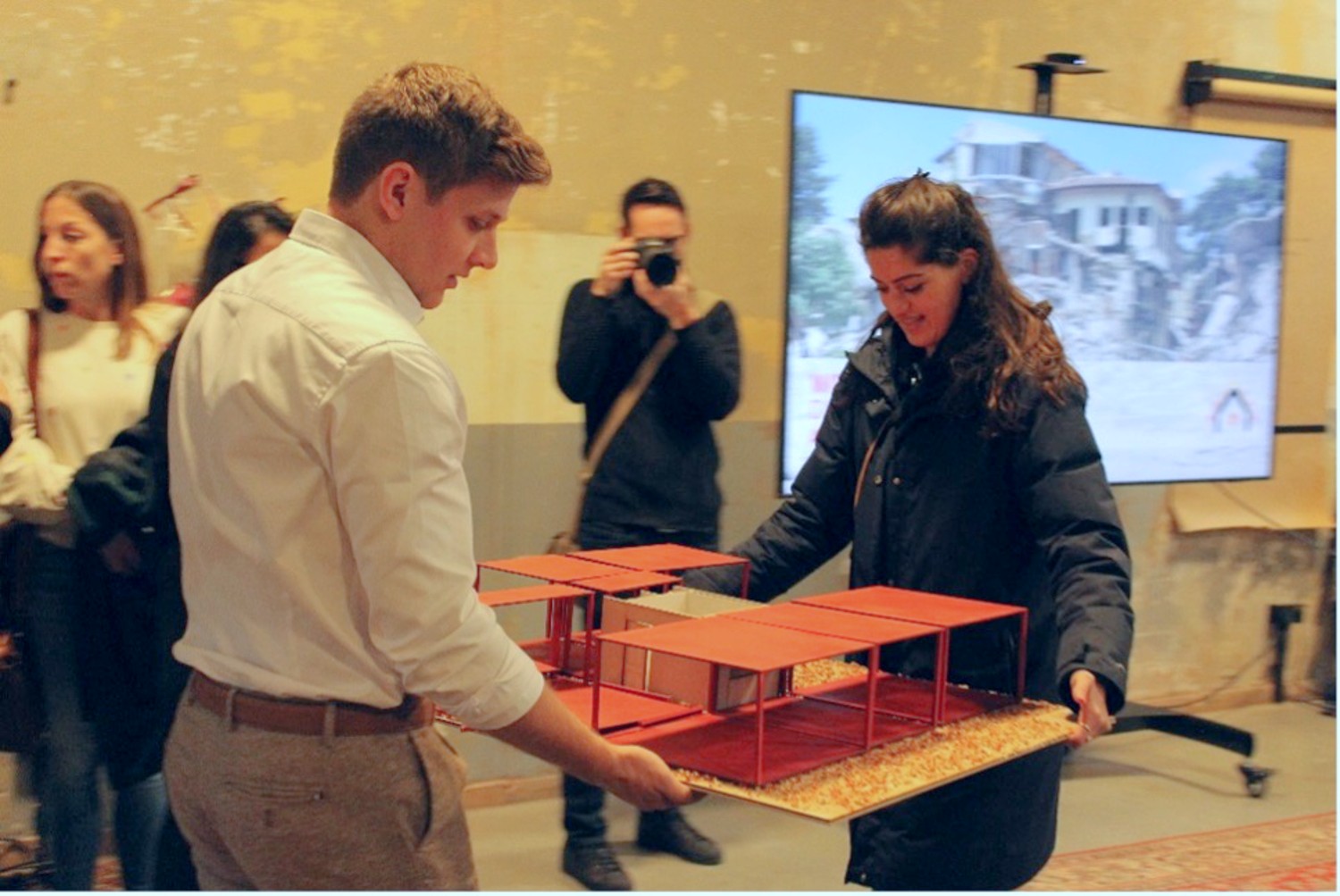Architecture students have designed a rural house for earthquake victims in Turkey, which they are set to build and test. Delta attended the design reveal.
Team members carry the model of the prototype at the design reveal. (Photo: ART)
A packed room filled with family, friends and the press eagerly awaits the unveiling of the design. Team members Leyla van der Waarde, Meriç Kessaf and Hena Micoogullari van Alphen take the audience through their turbulent journey from the earthquake in Turkey on 6 February 2023 to today. Over the months, the team has worked hard to design a new housing model for the earthquake victims. At the presentation on 23 November, the audience was full of praise and their reactions showed their admiration for the perseverance of the people standing before them.
Rolling up the sleeves
The shock of the earthquake in Turkey and Syria last February reverberated at TU Delft, where Van der Waarde and Kessaf study Architecture. Shortly after the disaster, driven by a shared desire to aid the people who lost their homes, they came together. Given that they were studying architecture, they soon came up with the idea of designing houses themselves. The ART (Architectural Recovery Team) was born and one month after the disaster they held a four-day workshop for students that generated 12 design concepts.
It didn’t stop at the workshop for the pair, as the subject is close to their hearts. Both have Turkish roots, with Kessaf’s family hailing from the heavily affected city of Antakya. During the presentation, Kessaf looks back. “The reason I started studying architecture was that an earthquake could happen there.”
A house to stay in
The team worked hard over the last couple of months, resulting in the prototype for a permanent home. Architect Micoogullari van Alphen unfolds the design, which is circular and flexible, during the presentation. Each house has the same core unit consisting of a kitchen, bathroom, storage space and technical equipment. Around the heart of the house, the dwelling can expand with a number of additional rooms. The shape and size of each complete design vary, depending on the wishes of the future residents. Ranging from a compact 78 square metres (m2) to more spacious layouts, the team prioritises a high quality of life. Notably, wheelchair accessibility was integrated, acknowledging victims who may have been disabled by the earthquake. The construction will probably consist of CLT (cross-laminated timber), which both makes it more sustainable and because people no longer feel safe in buildings made of concrete.

Some of the possible floor plans around the core unit.
Excursion to a ghost town
The design is the result of two trips to the affected region. Accompanied by experts, the team visited mayors and architects in Antakya and the surrounding area. Local children led them around ravaged neighbourhoods, an experience Kessaf vividly describes as resembling a ‘ghost town’.
Their five night stay in a container camp – housing for people who had lost their homes – left a profound impact on the team. “There was only one socket in each container. You had to choose between a fridge or a phone,” Kessaf recalls.

From left: Meriç Kessaf, Bengüsu İbiş Güner and Leyla van der Waarde at the site of the earthquake. (Photo: ART)
Constructing the prototype
The design is now ready to be built and tested. The construction cost of the first unit is EUR 40,000. A crowdfunding action has been launched for this purpose. After completion, the prototype will be extensively tested, including for earthquake resistance. It will then go by truck to Antakya, where additional rooms will be added. If the experiment succeeds, the team will decide if production can be scaled up. If so, the idea is that local people can produce everything on site using materials from the region.
Apart from their efforts in Turkey, ART aims to establish a knowledge-sharing platform. This repository will contain comprehensive manuals accessible worldwide, empowering people in similar disaster-stricken areas to start constructing themselves.
- Do you want to know more about the Architectural Recovery Team? Visit their website or help them reach their goal through crowdfunding.
- On Monday 11 December, ART was part of the Dutch documentary ‘Pauw in Turkije’. It can be watched here. Kessaf appears at minute 25:40.
- ART also has a group of students working on Morocco. A severe earthquake also struck there last September.
- This semester, the Extreme Architecture studio of the Master of Architecture at TU Delft is dedicated to the earthquakes in Turkey. The aim of the studio is to design an earthquake-resistant primary school with childcare in Antakya. The students organised a field trip and went to the site with 52 students and three teachers, where they talked to NGOs, children from the neighbourhood and several other people.
- Editor Nikita Ham is a student at the Faculty of Architecture and knows ART’s team members personally. She has followed their work closely over the past few months.

ART team members at the design unveiling. Left to right: Alizé Massonnet, Meriç Kessaf, Burcu Köken, Hena Micoogullari van Alphen, Leyla van der Waarde and Job Schroën. (Photo: ART)
Nikita Ham / Student-redacteur



Comments are closed.